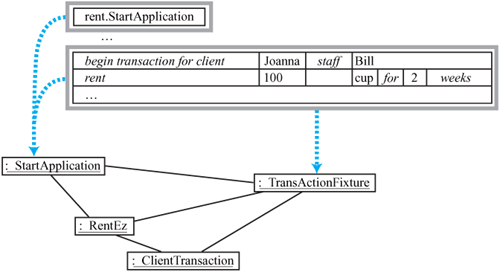Section 33.6. Transaction Fixture
33.6. Transaction Fixture"Now we need a fixture that connects to the ClientTransaction in RentEz and carries out actions on it," Emily suggested.[1]
"Yes," replied Neo, "we can pass the ClientTransaction object to it when we create the DoFixture." Emily added support for transactions through a separate DoFixture object. The method beginTransactionForClientStaff() in class StartApplication, as shown in Listing 33.4, corresponds to the first action in the Fit table in Figure 33.3. Listing 33.4. StartApplication.java (part 3) public class StartApplication extends DoFixture { private RentEz rentEz; public Fixture beginTransactionForClientStaff(String clientName, String staffMemberName) throws MissingException { ClientTransaction transaction = rentEz.beginClientTransaction( clientName,staffMemberName); return new TransActionFixture(rentEz,transaction); } } This method returns a new transActionFixture, which defines methods corresponding to the actions used in a transaction table. For example, four of the methods of class transActionFixture are shown in Listing 33.5. Figure 33.4 shows the interaction of the tables, fixtures, and application objects for tests involving a business transaction. Note how the TRansActionFixture object acts directly on the ClientTransaction object within the system under test. Figure 33.4. Managing a Business Transaction Questions & Answers
As the separation of the domain objects and the UI is carried out, one roadblock to testing has been removed. The next hurdle is domain objects that have database managementor other forms of persistencetangled within them. |
EAN: 2147483647
Pages: 331
- ERP System Acquisition: A Process Model and Results From an Austrian Survey
- Enterprise Application Integration: New Solutions for a Solved Problem or a Challenging Research Field?
- Intrinsic and Contextual Data Quality: The Effect of Media and Personal Involvement
- Relevance and Micro-Relevance for the Professional as Determinants of IT-Diffusion and IT-Use in Healthcare
- Development of Interactive Web Sites to Enhance Police/Community Relations